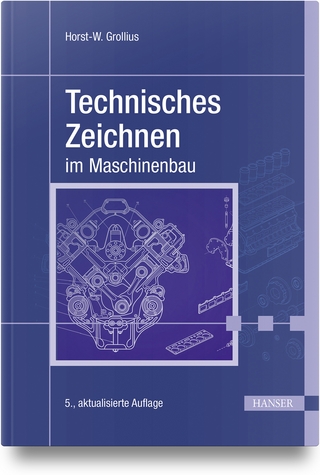
The Kinematic Geometry of Gearing
John Wiley & Sons Inc (Verlag)
978-0-471-04597-7 (ISBN)
- Titel ist leider vergriffen;
keine Neuauflage - Artikel merken
Furthermore, it has been proven capable of greatly facilitating the design and manufacture of new devices, revealing heretofore unexplained phenomena which currently hinder the advancement of the gearing art beyond application to constant speed transmission. It also provides a means of developing and manufacturing tools and gear forms which were previously difficult to conceptualize or implement. The Kinematic Geometry of Gearing is divided into three sections, with the first being devoted to introducing the basic concepts and various types of toothed motion/force transmission mechanisms. Part II builds upon those concepts to develop a comprehensive methodology that can be applied to the design and manufacture of various types of gears and motion function generators. Part III discusses the design procedure itself. The authors supply a number of simplified design formulas, and, with the help of numerous examples, they clearly illustrate the capabilities of this versatile new approach to the integrated, interactive CAD/CAM of gear pairs and their production process.
This groundbreaking book presents an entirely new and comprehensive methodology for the design, manufacture and evaluation of gears and virtually all other types of toothed motion/force transmission mechanisms. In it, the authors develop the kinematic relationships necessary to design and manufacture gear pairs and, with the help of the enclosed software, demonstrate how those relationships can utilize the design specification in an interactive PC environment to produce the design and manufacturing information and performance characteristics concurrently. A powerful new tool for evaluating and enhancing the performance of gear pairs and dealing with previously unexplained phenomena An evolutionary leap in the design and manufacture of gear pairs provides a method for developing and manufacturing tools and gear forms which were previously difficult to conceptualize or implement Design formulas and numerous real-world examples clearly illustrate the capabilities of this versatile new approach Enclosed disk demonstrates to designers how to implement the described method into a fully integrated CAD and CAM process
About the authors DAVID B. DOONER, PhD, is Assistant Professor in the Department of Mechanical Engineering at the University of Puerto Rico in Mayaguez. He received his doctorate from the University of Florida at Gainesville in 1991 where he remained as a Post-Doctoral Fellow from 1991-1994. He worked at the General Motors Gear Center in 1989 and was a visiting scientist at the Mechanical Sciences Research Institute of the Russian Academy of Sciences in Moscow in 1992. ALI A. SEIREG, PhD, is Kaiser Professor at the University of Wisconsin at Madison and Ebaugh Professor at the University of Florida at Gainesville. He received his degree from the University of Wisconsin in 1954 and has had an extensive career in engineering, education, and industry. He has served as consultant for numerous industrial, governmental and scientific organizations and has been consultant to the FALK Corporation since 1956. He founded and served as chairman of the Computer Engineering Division of ASME and was the editor of the ASME Hybrid Journal on Computers in Mechanical Engineering, CIME. Dr. Seireg has chaired many international conferences and held numerous offices in national and international organizations, including the Presidency of the ASME/AGMA Gear Research Institute from 1983 to 1993, the chairmanship of the ASME Council on Engineering from 1985 to 1989, and the Executive Council of the International Federation of Theory of Machines and Mechanisms from 1983 to 1991. His honors and awards include the 1970 George Westinghouse Award of ASEE, the Richards Memorial Award of ASME in 1973, the E. P. Connell Award of AGMA in 1974, the ASME Machine Design Award in 1978, the Kuwait Prize for Science in 1987, and the ASME Design Automation Award in 1990. He was elected an honorary member of the Chinese Mechanical Engineering Society in 1986, a Foreign Member of the Russian Academy of Science in 1988, and Honorary Life Member of the ASME/AGMA Gear Research Institute in 1994.
FUNDAMENTAL PRINCIPLES OF TOOTHED BODIES IN MESH. Introduction to the Kinematics of Gearing. THE KINEMATIC GEOMETRY OF CONJUGATE MOTION IN SPACE. Kinematic Geometry of Conjugate Tooth Profiles. Generalized Reference Coordinates for Spatial Gearing: The Cylindroidal Coordinates. Analysis of Toothed Bodies for Motion Generation. Manufacture of Toothed Bodies. Surface Topology and Conjugate Surfaces. THE INTEGRATED DESIGN AND MANUFACTURING PROCESS. Geometric Synthesis Process. Integrated Interactive Process. Case Illustrations of the Integrated CAD/CAM Methodology. Appendices. Glossary. References. Index.
| Erscheint lt. Verlag | 2.3.1995 |
|---|---|
| Reihe/Serie | Design Engineering |
| Zusatzinfo | ill |
| Verlagsort | New York |
| Sprache | englisch |
| Maße | 167 x 244 mm |
| Gewicht | 840 g |
| Themenwelt | Informatik ► Weitere Themen ► CAD-Programme |
| Technik ► Maschinenbau | |
| ISBN-10 | 0-471-04597-7 / 0471045977 |
| ISBN-13 | 978-0-471-04597-7 / 9780471045977 |
| Zustand | Neuware |
| Haben Sie eine Frage zum Produkt? |
aus dem Bereich


